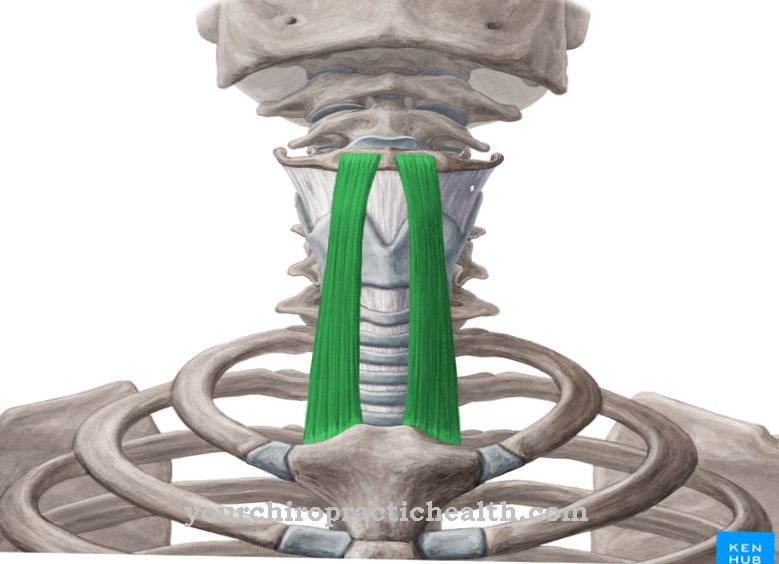During pregnancy, the so-called Mucus plug. Its job is to close the cervix. If the pregnant woman is shortly before the beginning of the birth process, it will separate. Many pregnant women notice the loosening of the mucus plug because they notice light bleeding, which is also known as "drawing bleeding" or "drawing".
What is the function of a mucus plug?
When a woman becomes pregnant, her body changes; he begins to adapt to the fact that a child grows in the woman's body. The glands in the area of the cervix produce thick mucus. The mucus that is produced forms the Mucus plugthat closes the cervix.
The "Kristellsche Schleimpfropf", named after Samuel Kristeller - a German gynecologist - is supposed to prevent bacteria from entering. This protects the uterus and, subsequently, the growing child. But the mother also benefits from the mucus plug; this prevents any bacteria in the uterus from causing infections that can affect the mother's health.
The mucous plug also stabilizes the uterus so that premature births can be prevented. Even if the mucus plug goes unnoticed in many cases, as many pregnant women do not even notice that it is detached, it has an incredibly important task that it has to pursue during pregnancy. In this way, it not only prevents premature births, but also protects the mother and child from any bacteria or infections and diseases.
How is the mucus plug noticeable?
The size and appearance of the plug vary widely. This means that the mucus plug - depending on the woman - can be of different sizes; The appearance can also be different - depending on the woman. The amount can be so small that many women do not even notice that the mucus plug has come off. If the mucus plug loosens, this is a sure sign of the beginning of the birth process.
Women notice the discharge as an increased discharge, although sometimes - if it is a large plug of mucus - thick mucus is noticed. The mucus plug is whitish if it is without blood. In many cases, however, blood can be seen. If there are traces of blood in the mucus plug, this is not a bad sign, but merely an indication that the cervix is already slightly open.
The blood that is visible in the mucus plug comes from vessels in the uterine lining. The small vessels tear when the cervix opens, so that blood can be seen. This bleeding is also often described as a drawing bleeding. Depending on whether you can see fresh or old blood, the mucus plug can be brownish or light red.
However, if the pregnant woman does not notice that the mucus plug has come off, this is in truth irrelevant. If the mucus plug has come off unnoticed, the pregnant woman has only missed the first sign, which indicates that it can only be a few days before the first labor pains begin.
Why is the mucus plug loosening?
When the mucus plug is removed (from the 38th week of pregnancy), the theoretical birth process is triggered. As a rule, the loosening of the mucus plug is a sure sign that the woman is about to give birth and that the so-called opening phase is already imminent. If the pregnant woman has noticed that the mucus plug has come off, a few days may pass before the first labor pains can actually be felt.
For this reason, if the mucus plug has come off, the woman does not have to contact a doctor immediately or go to a hospital. Only when regular labor pains are felt should a doctor be contacted or hospitalized. Even if the detachment of the mucous plug represents the actual start of labor, it does not mean that the woman will have her child in a few hours.
By detaching the mucous plug, the body only announced that the cervix was opening and that the child was ready to finally be born. However, if regular and prolonged bleeding occurs, and the pregnant woman discovers large amounts of bright red and fresh blood, a doctor should be consulted immediately.
Especially when the loss of fresh blood is painful. In these cases, it is usually not the so-called drawing bleeding, but sometimes a premature detachment of the placenta. A condition that should by no means be ignored; immediate medical attention is required here.
Departure of the mucus plug: the birth begins
The body produces prostaglandins when the baby is ready for birth. On the one hand, the hormone changes the tissue of the cervix (cervical maturation follows) and, on the other hand, it ensures the removal of the mucous plug. Sometimes practice pains or first labor pains can also mean an opening phase of the birth, so that the cervix opens slightly and then the mucus plug comes off.
Once the mucus plug has loosened, the pregnant woman can be sure that it will only take a few days before the child is born. Since pregnancy is a test of patience for many women, the release of the mucus plug is perceived as a redeeming sign.




.jpg)



.jpg)





.jpg)






.jpg)






